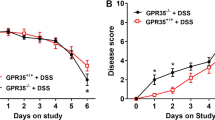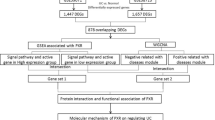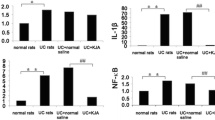Abstract
Background. Peroxisome proliferator activator receptor-gamma (PPARγ) is a member of the nuclear receptor superfamily. Ligands of PPARγ, thiazolidione derivatives, have been reported to be the one of the candidates for the treatment of inflammatory bowel disease (IBD). Given the fact that PPARγ is a transcription regulator, expression pharmacogenomics, including differential gene expression profiling of drug responses in a colitis model, is thought to be a useful approach for finding relevant genes that can serve as the target for new drug treatment of IBD. Methods. We performed a global analysis for differential gene expression of the intestine in a dextran sodium sulfate (DSS) colitis mouse model following PPARγ ligand administration. By applying a high-density oligonucleotide array method, the expression patterns of approximately 12000 genes were analyzed, and selected genes were confirmed by a real-time quantitative PCR method. Results. The analysis of downregulated genes in the DSS mice following PPARγ administration revealed several functional gene clusters with altered expression: (1) oncogene families such as GRO1 oncogenes, (2) inflammatory mediator-related genes such as the interferon-gamma gene, (3) water electrolyte-associated genes, and (4) others. Conclusions. This is the first demonstration of global gene expression analysis using the DSS colitis mouse model with a PPARγ ligand, and these results provide new insight for finding novel target genes for treating IBD.
Similar content being viewed by others
References
vanDullemen HM, vanDeventer SJ, Hommes DW, Bijl HA, Jansen J, Tytgat GN, Woody J. Treatment of Crohn’s disease with anti-tumor necrosis factor chimeric monoclonal antibody (cA2). Gastroenterology 1995;109:129–35.
Lawrance IC, Fiocchi C, Chakravarti S. Ulcerative colitis and Crohn’s disease: distinctive gene expression profiles and novel susceptibility candidate genes. Hum Mol Genet 2001;10:445–56.
Uthoff SM, Eichenberger MR, Lewis RK, Fox MP, Hamilton CJ, McAuliffe TL, et al. Identification of candidate genes in ulcerative colitis and Crohn’s disease using cDNA array technology. Int J Oncol 2001;19:803–10.
Dieckgraefe BK, Stenson WF, Korzenik JR, Swanson PE, Harrington CA. Analysis of mucosal gene expression in inflammatory bowel disease by parallel oligonucleotide arrays. Physiol Genomics 2000;4:1–11.
Gelman L, Fruchart JC, Auwerx J. An update on the mechanisms of action of the peroxisome proliferator-activated receptors (PPARs) and their roles in inflammation and cancer. Cell Mol Life Sci 1999;55:932.
Kersten S, Wahli W. Peroxisome proliferator activated receptor agonists. EXS (Basel) 2000;89:141.
Chinetti G, Fruchart JC, Staels B. Peroxisome proliferator-activated receptors (PPARs): nuclear receptors at the crossroads between lipid metabolism and inflammation. Inflamm Res 2000; 49:497.
Nakajima A, Wada K, Miki H, Kubota N, Nakajima N, Terauchi Y, et al. Endogenous PPAR gamma mediates anti-inflammatory activity in murine ischemia-reperfusion injury. Gastroenterology 2001;120:460–9.
Hippo Y, Taniguchi H, Tsutsumi S, Machida N, Chong JM, Fukayama M, et al. Global gene expression analysis of gastric cancer by oligonucleotide microarrays. Cancer Res 2002;62:233–40.
Saubermann LJ, Beck P, DeJong YP, Pitman RS, Ryan MS, Kim HS, et al. Activation of natural killer T cells by alpha-galactosylceramide in the presence of CD1d provides protection against colitis in mice. Gastroenterology 2000;119:11–6.
Hippo Y, Yashiro M, Ishii M, Taniguchi H, Tsutsumi S, Hirakawa K, et al. Differential gene expression profiles of scirrhous gastric cancer cells with high metastatic potential to peritoneum or lymph nodes. Cancer Res 2001;61:889–95.
Rajeevan MS, Ranamukhaarachchi DG, Vernon SD, Unger ER. Use of real-time quantitative PCR to validate the results of cDNA array and differential display PCR technologies. Methods (Orlando) 2001;25:443–51.
Ierardi E, Principi M, Francavilla R, Passaro S, Noviello F, Burattini O, Francavilla A. Epithelial proliferation and ras p21 oncoprotein expression in rectal mucosa of patients with ulcerative colitis. Dig Dis Sci 2001;46:1083–7.
Lang SM, Heinzlmann M, Stratakis DF, Teschauer W, Loeschke K. Detection of Ki-ras mutations by PCR and differential hybridization and of p53 mutations by SSCP analysis in endoscopically obtained lavage solution from patients with long-standing ulcerative colitis. Am J Gastroenterol 1997;92:2166–70.
Bisping G, Lugering N, Lutke-Brintrup S, Pauels HG, Schurmann G, Domschke W, Kucharzik T. Patients with inflammatory bowel disease (IBD) reveal increased induction capacity of intracellular interferon-gamma (IFN-gamma) in peripheral CD8+ lymphocytes co-cultured with intestinal epithelial cells. Clin Exp Immunol 2001;123:15–22.
Salomon P, Pizzimenti A, Panja A, Reisman A, Mayer L. The expression and regulation of class II antigens in normal and inflammatory bowel disease peripheral blood monocytes and intestinal epithelium. Autoimmunity 1991;9:141–9.
Turtzo LC, Lee MD, Lu M, Smith BL, Copeland NG, Gilbert DJ, et al. Cloning and chromosomal localization of mouse aquaporin 4: exclusion of a candidate mutant phenotype, ataxia. Genomics 1997;41:267–70.
Narushima Y, Unno M, Nakagawara K, Mori M, Miyashita H, Suzuki Y, et al. Structure, chromosomal localization and expression of mouse genes encoding type III Reg, RegIII alpha, RegIII beta, RegIII gamma. Gene (Amst) 1997;185:159–68.
Author information
Authors and Affiliations
Rights and permissions
About this article
Cite this article
Nakajima, A., Wada, K., Katayama, K. et al. Gene expression profile after peroxisome proliferator activator receptor-γ ligand administration in dextran sodium sulfate mice. J Gastroenterol 37 (Suppl 14), 62–66 (2002). https://doi.org/10.1007/BF03326416
Published:
Issue Date:
DOI: https://doi.org/10.1007/BF03326416




